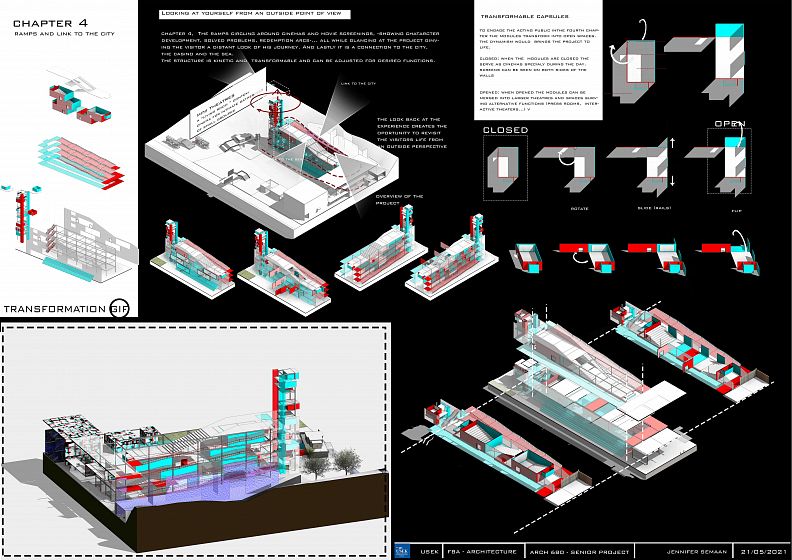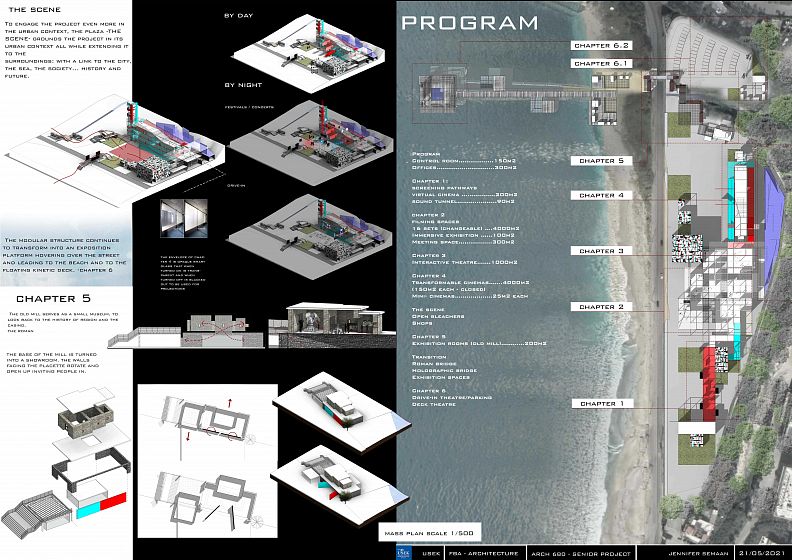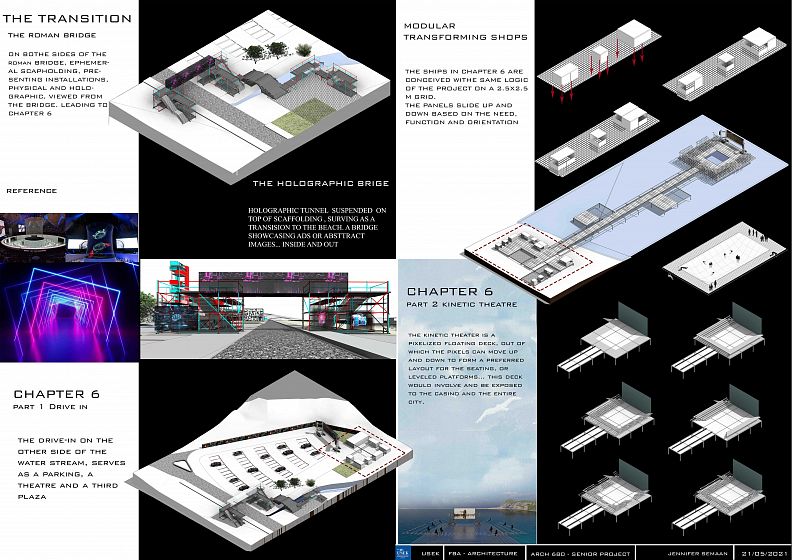THE GLITCH-A CINEMATIC REHABILITAION

Project idea
Human recovery is the foundation upon which correctional facilities are developed. Based on the studies of Neuro- architecture and the analysis of the effect of architecture on human behavior, the success of a rehabilitation program is greatly supported when the program's spirit and purpose are expressed in the institution's architecture. Additionally, Architecture in movies play an immense role on the outcome of a character as well as the story telling, which in turn affects the viewer in many ways. Based on the studies conceived on neuro-cinema and cinema therapy, it is expected that it would benefit juveniles greatly on their journey of rehabilitation.
the goal is to create a responsive and interactive space, where the main objective is to set people unknowingly on a journey of self-discovery, recovery and rehabilitation with the help of architecture and cinema. thus, creating a space of flows acting as an urban catalyst for cultural, emotional, sentimental, exchange and transformation.
Project description
The GLITCH, is a responsive and interactive space, where the main objective is to set people -without them realizing it- on a journey of self-discovery, and rehabilitation with the help of architecture and cinema. Thus, creating a space of flows and paths acting as an urban, moving and living organism leading people into recovery and social reintegration.
The project is a “plug-in” to the street of Maameltein, a glitch in the social reality of the site. a series of experiences offering a therapeutic journey. The visitor is transformed from a “spectator” to an “actor” in their own life. Through the experiences, architectural and cinematic process the “actor” is more in touch with their feelings, sentiments, realities, fantasies, and problems…
The program will be a process connecting art, media, technology, and therapy in a linear disposition that is transformable, dynamic, ever changing, and reminiscent of a film set. These installations of interventions and social knots connected to facilitate a seamless journey of cinematic rehabilitation on an individual and social level. the interventions being either visual, audible, or tactile…simulations, would add up and build up in form of “Crescendo” with the final step being the peak after acceptance. The project is divided into CHAPTERS, each chapter encompasses permanent and ephemeral structures.
The design of the GLITCH entails overlapping translucent layers and textured layers, using a palette of sheer colors, the overall effect draws attention to the chapters, turning the volume into a beacon and making it seem like an architectural illusion. The colors chosen are RED and CYAN to pays homage to the “Anaglyph 3D”, the stereoscopic 3D effect achieved by means of encoding each eye's image using filters of different colors. Using the anaglyph glasses would change the appearance of the project.
The permanent structures appear in a texture of anaglyph art that, by using glasses, a two-dimensional wall turns into a three-dimensional volume of pixelated cubes. The use of effect can engage the curiosity and engagement of by passers.
Given the kinetic and ephemerality of the functions linking the permanent structures, the project consists of a three-dimensional steel structure based on a 10x10 grid containing panels and screens that can be transformed according to the needs and continuously adapting to different themes/movies. The plazas (THE SCENES) are the social catalysts and the connections between the project and its surroundings.
The complex mixes visual attraction, kinetic energy, transformable/ adjustable spaces: a moving never still scenery, representing the juvenile dynamic.
Technical information
The CHAPTERS,
Each chapter encompasses ephemeral and permanent structures based on a 10x10 grid, which helps with the transformability of the project.
The permanent structures are painted with anaglyph art that turns 2D walls into pixelated 3D volumes with the help of the 3d glasses
The colors chosen are red and cyan to pays homage to the “anaglyph 3d”, using the 3d glasses would change the appearance of the project. Which increases the curiosity of by passers towards what seems like an unreal architectural illusion
The first chapter, is on an individual level, each person navigates the path in a different way by connecting to certain characters or certain storylines projected on the screens. Arriving at the virtual cinema where a specific chosen moment can be amplified into virtual reality
The second chapter is transitioning the person from a virtual state of being into a real-life intervention. It’s a series of filming sets used by everyone including directors cinematography students or hobbyists that become the intervention themselves and where the person can either observe or or participate in the storytelling through filming or sharing their stories in the meeting spaces that manifest in immersive rooms
The third chapter is an interactive “choice-based gaming theater on the ground floor with its wall projected to the floor above through holograms. Creating a connection between players and the rest of the visitors
The fourth chapter is a series of modular theaters that can be transform based on the need and can double the space by opening up towards one another by rotating or sliding panels placing the person in a slightly bigger crowd.
The ramps wrapping around the volume create an interaction when the spaces are open
The peak of the crescendo is reached through the tower housing mini cinemas providing an intimate setting for the visitors. As well as serving as a lookout and establishing a connection with the city the casino and the sea
The volume consists of layering colored panels and smart projection glass that when turned on serves as a massive projection screen to an audience below it.
The scene is where all the chapters are connected, it’s the social catalyst that can be used for festivals and for events.
It’s includes the old mill that is transformed into a museum the roman bridge that is now a part of a transition along with a holographic tunnel leading to the drive in and the kinetic deck theater in the sea.


















